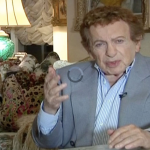It may surprise you to learn that I am a member of the Reform rabbinate. At least officially. Of course, on matters of ideology I am no Reform Jew, at least not in any way that matters to today’s definition of Reform Judaism
I’ve written before about the tragic mistake made by official Reform Judaism when it rejected the membership of a humanistic Cincinnati congregation. Since then, the Reform movement has become an increasingly inhospitable home for non-believing Jews.
So imagine my surprise when I opened the Summer 2012 issue of Reform Judaism magazine and found Rabbi Mark Dov Shapiro’s article, “The God Survey.”
He polled his congregation in Springfield, Massachusetts only to find that a significant number of his congregants were non-believers or barely believers. Fifteen percent said flat-out that there is no God (33% of men, 8% of women) and of those in their twenties, 25% agreed that there is no God.
Keep in mind that these responses are from congregational members who cared enough to take the time to respond to their rabbi! I would venture to guess – though it is an educated guess – that this is just the tip of the iceberg.
Of those who did believe, most identified God as “love” or “hope.” Most also believed that to the extent that God acts at all in these guises of love and hope, it is only through human beings. Rabbi Shapiro comes to a radically honest conclusion:
I find it significant that this metaphor of God as hope or love is largely absent from Reform liturgy. No wonder that some people feel disenfranchised coming to services where the prevailing God metaphor is Melech or Ruler. Broadening the vocabulary of worship to include new God language for the majority of my congregants may be my next step as a rabbi.
While I certainly differ on the significance of any “God metaphor,” I can appreciate the dawning realization coming upon this rabbi. His movement is severely out of touch.
The Reform movement is largely directed by people who think that more traditional religious behavior and language is the key to success. Its new prayer book is its most traditional to date. Its predecessor provided a (mostly) non-theistic service among its many choices. Such open minded options are completely gone in the new version as it instead marks a return to traditional language, including the resurrection of the dead.
I don’t know if this trend comes from true belief or from a desperate response to the rising popularity of Orthodoxy. In any case, the movement has become increasingly deaf to the beliefs of many, if not most, of its constantly decreasing membership.
Speaking of membership, I spoke to a friend of mine who is a member of a large Reform temple. She informed me that based upon her modest middle class family income, her temple dues are now $3,000 plus $1,000 more for one religious school tuition. Meanwhile, the senior rabbi has a very secure contract that pays him in the mid-six figures.
Reform Judaism is clearly built upon a shifting hill of sand. It has virtually no shot at surviving in a world where more and more Jews are non-believers and/or “Just Jewish.” It is led by a high priesthood of out-of-touch, elitist and wildly overpaid clergy who are pushing its theology rightward. It is little wonder that young non-Orthodox Jews view affiliation as an unaffordable and undesired luxury. Reform Jewish leaders will soon discover that they have created a hollow version of Orthodoxy, minus the sincerity and commitment.
Given the great good that Reform Judaism brought to the Jewish enterprise, I certainly hope it evolves in the right direction before it collapses.
Meanwhile I’ll put my money on Humanistic Judaism. We may not have Reform’s enormous infrastructure, but we make up for it with a relevant message for millions of Jews.














